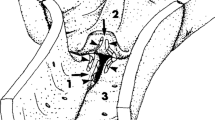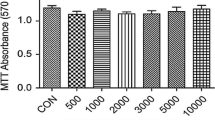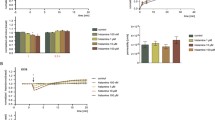Abstract
Objective
To study the effects of estrogen on transendothelial paracellular permeability in women.
Methods
Human umbilical vein endothelial cells (HUVEC) obtained from women were grown on filters. The paracellular permeability characteristics were determined in terms of changes in the prmeability to the polar acid pyranine (Ppyr) and as changes in the transendothelial electrical resistance (RTE). Tight junctional resistance characteristics were assayed by lowering luminal NaCl and measuring the dilution potential, and were expressed as the ratio of monion mobility uCl/uNa (cation selectivity).
Results
Low extracellular calcium and hyperosmolarity increased Ppyr and decreased RTE. The former but not the latter condition abolished the endothelium-specific cation selectivity. Treatment with 10 nM of estradiol-17β had no effect on RTE, but it increased the cation selectivity. The effect of estradiol required 1-6 hours’ incubation with the hormone; it was dose dependent and saturable, with a median effective concentration of estradiol of 1 nM. Diethylstilbestrol, but not estriol, could mimic the effect of estradiol, and the estrogen rectpro antagonist ICI-182,780 blocked it.
Conclusion
Cultured HUVEC cells from patent tight junctions. Estrogens increase the cation selectivity across HUVEC cultures. The effect of estrogen may be mediated by an estrogen receptor. These effects may be important for vasculoprotection in cases of sudden changes in ions levels across the capillary wall, such as ischemia or reperfusion.
Similar content being viewed by others
References
Renkin EM. Cellular and intercellular transport pathways in exchange vessels. Am Rev Respir Dis 1992; 146: 528–31.
Clough, G. Relationship between microvascular permeability and ultrastructure. Prog Biophys Mol Biol 1991; 55: 47–69.
Bassenge E. Endothelial function in different organs. Prog Car-diovasc Dis 1996; 39: 209–28.
Dejana E, Corada M, Lampugnani MG. Endothelial cell-to-cell junctions. EASEB J 1995; 9: 910–8.
Leach L, Firth JA. Structure and permeability of human placental microvasculature. Microsc Res Tech 1997; 38: 137–44.
Mithel CC. Transport of macromolecules through microvascular walls. Cardiovasc Res 1996; 32: 644–53.
Gorodeski GI, Romero MP, Hopfer U, Rorke E, Utian WH, Eckert RL. Human uterine cervical epithelial cells grown on permeable support—a new model for the study of differentiation and transepithelial transport. Differentiation 1994; 56: 107–18.
Gorodeski GI, De Santis BJ, Goldfarb J, Utian WH, Hopfer U. Osmolar changes regulate the paracellular permeability of cultured human cervical epithelium. Am J Phvsiol 1995; 269: C870–7.
Gorodeski GI, Peterson D, De Santis BJ, Hopfer U. Nucleotide-receptor mediated decrease of tight-junctional permeability in cultured human cervical epithehum. Am J Physiol 1996; 270: C1715–25.
Gorodeski GI, Wenwu J, Hopfer U. Extracellular Ca2+ directly regulates tight junctional permeability in the human cervical cell line CaSki. Am J Physiol 1997; 272: C511–24.
Tschugguel W, Zhegu Z, Gajdzik L, Maier M, Binder BR, Graf J. High precision measurement of electrical resistance across endothelial cell monolayers. Eur J Physiol 1995; 430: 145–7.
Ussing HH, Zerahn K. Active transport of sodium as the source of electric current in the short-circuited isolated frog skin. Acta Physiol Scand 1951; 23: 110–27.
Reuss L. Tight junction permeability to ions and water. In: Gereijido, M, ed. Tight-junctions. Boca Raton, Florida: GRC Press, 1991; 49–66.
Stathenfeld NS, DiPietro L, Palter SF, Nadel ER. Estrogen influences osmotic secretion of AVP and body water balance in postmenopausal women. Am J Physiol 1998; 274: R187–95.
Pecins-Thompson M, Keller-Wood M. Effects of progesterone on blood pressure, plasma volume, and responses to hypotension. Am J Physiol 1997; 272: R377–85.
Ziats NP, Anderson JM. Human vascular endothelial cell attachment and growth inhibition by type V collagen. J Vasc Surg 1993; 17: 710–8.
Gorodeski GI, Eckert RL, Utian WH, Rorke EA. Maintenance of in vivo-like keratin expression, sex steroid responsiveness and estrogen receptor expression in cultured human ectocervical epithelial cells. Endocrinology 1990; 126: 399–406.
Greene GL, Gilna P, Waterfield M, Baker A, Hort Y, Shine J. Sequence and expression of human estrogen receptor DNA. Science 1986; 231: 1150–4.
Kuiper GGJM, Carlsson B, Grandien K, et al. Comparison of the ligand binding specificity and transcript tissue distribution of estrogen receptors a and p. Endocrinology 1997; 138: 863–69.
Siegel S. Nonparametric statistics for the behavioral sciences. London: McGraw-Hill 1956.
Tucker VL, Victonno GP. Methods for studying microvascular barrier function in isthemia-reperfusion injurv. Shock 1997; 8: 8–15.
Berthois Y, Katzenellenbogen JA, Katzenellenbogen BS. Phenol red in tissue culture medium is a weak estrogen: Implication concerning the study of estrogen-responsive cells in culture. Proc Nad Acad Sci USA 1986; 83: 2496–501.
Wakeling AE, Bowler j. ICI 182,780, a new antioestrogen with clinical potential. J Steroid Biothem Mol Biol 1992; 43: 173–7.
Furuse M, Hirase T, Itoh M, et al. Occludin: A novel integral membrane protein localizing at tight junctions. J Cell Biol 1993; 123: 1777–88.
Stuart RO, Sun A, Panichas M, Hebert SC, Brenner BM, Nigam SK. Critical role for intracellular calcium in tight junction biogenesis. J Cell Physiol 1994; 159: 423–33.
Stuart RO, Sun A, Bush KT, Nigam SK. Dependence of epithelial intercellular junction biogenesis on thapsigargin-sensitive intracellular calcium stores. J Biol Thern 1996; 271: 13636–41.
Hangxin L, Pozmansky MJ. Characterization of the ZO-1 protein m endothlial and other cell hnes. J Cell Sci 1990; 97: 231–7.
Anderson JM, Balda MS, Fanning AS. The structure and regulation of tight junctions. Curr Opin Cell Biol 1993; 5: 772–8.
Zahraoui A, Joberty G, Arpin M, et al. A small rab GTPase is distributed in cytoplasmic vesicles in non polarized cells but colocalizes with the tight junction marker ZO-1 in polarized epithelial cells. J Cell Biol 1994; 124: 101–5.
Anstead GM, Carlson KE, Katzenellenbogen JA. The estradiol pharmacophore: Ligand structure-estrogen receptor binding affinity relationships and a model for the receptor binding site. Steroids 1997; 62: 268–303.
Kim SS, McGowan KA, Hubchak SC, et al. Expression of an estrogen receptor by human coronary artery and umbilical vein endothelial cells. Circuladon 1996; 94: 1402–7.
Venkov CD, Rankin AB, Vaughan DE. Identificadon of authen-tic estrogen receptor in cultured endothehal cells: A potential mechanism for steroid hormone regulation of endothelial function. Circulation 1996; 94: 727–33.
Baker VL, Chao VA, Murai JT, Zaloudek CJ. Taylor RN. Human umbilical vessels and cultured umbilical vein endothelial and smooth muscle cells lack detectable protein and mRNA-encoding estrogen receptors. J Soc Gyn Invest 1997; 4: 316–24.
Conger JD, Weil JV. Abnormal vascular function following isthemia-reperfusion injury. J Invest Med 1995; 43: 431–42.
Ward BJ, Firth JA. Effect of hypoxia on endothehal morphology and interendothelial juncrions in the isolated perfused rat heart. J Mol Cell Cardiol 1989; 21: 1337–47.
Gorodeski GI. Mechanisms of action for estrogen in cardio-protection. In: Wren BG, ed. Progress in the management of menopause. Camforth, Lancashire, United Kingdom: Parthenon, 1997: 402–18.
Kim YD, Then B, Beauregard J, et al. 17-beta-Estradiol prevents dysfunction of canine coronary endothelium and myocardium and reperfusion arrhythmias after brief isthemia/reperfusion. Circulation 1996; 94: 2901–8.
Levy MN, Utian WH, Tang T, Goldfarb J, Gorodeski GL. Effects of estrogen on cardiac stunning in female rabbits (abstract). Menopause 1997; 4: 246(S-2).
Jennings RB, Steenbergen C Jr, Reimer KA. Myocardial isthemia and reperfusion. Monogr Pathol 1995; 37: 47–80.
Author information
Authors and Affiliations
Corresponding author
Additional information
Supported in part by grants from Bristol Myers Squibb Company (US Phannaceuticals) to G. 1. G., and from the National Institutes of Health, Heart. Lung, and Blood Institute. Grant HL-48771, to N. P. Z. Dr. Alan Wakeling (Zeneca Pharmaceuticals) is acknowl edged for providing the ICI–182,780.
Rights and permissions
About this article
Cite this article
Cho, M.M., Ziats, N.P., Abdul-Karim, F.W. et al. Effects of Estrogen on Tight Junctional Resistance in Cultured Human Umbilical Vein Endothelial Cells. Reprod. Sci. 5, 260–270 (1998). https://doi.org/10.1177/107155769800500507
Published:
Issue Date:
DOI: https://doi.org/10.1177/107155769800500507




